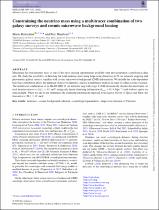| dc.contributor.author | Ballardini, Mario | |
| dc.contributor.author | Maartens, Roy | |
| dc.date.accessioned | 2022-09-20T12:08:43Z | |
| dc.date.available | 2022-09-20T12:08:43Z | |
| dc.date.issued | 2022 | |
| dc.identifier.citation | Ballardini, M., & Maartens, R. (2022). Constraining the neutrino mass using a multitracer combination of two galaxy surveys and cosmic microwave background lensing. Monthly Notices of the Royal Astronomical Society, 510(3), 4295-4301. 10.1093/mnras/stab3480 | en_US |
| dc.identifier.issn | 1365-2966 | |
| dc.identifier.uri | 10.1093/mnras/stab3480 | |
| dc.identifier.uri | http://hdl.handle.net/10566/7932 | |
| dc.description.abstract | Measuring the total neutrino mass is one of the most exciting opportunities available with next-generation cosmological data
sets. We study the possibility of detecting the total neutrino mass using large-scale clustering in 21 cm intensity mapping and
photometric galaxy surveys, together with cosmic microwave background (CMB) information. We include the scale-dependent
halo bias contribution due to the presence of massive neutrinos, and use a multitracer analysis in order to reduce cosmic variance.
The multitracer combination of an SKAO-MID 21 cm intensity map with stage 4 CMB dramatically shrinks the uncertainty on
total neutrino mass to σ(Mν ) 45 meV, using only linear clustering information (kmax = 0.1 h Mpc−1
) and without a prior on
optical depth. When we add to the multitracer the clustering information expected from Legacy Survey of Space and Time, the
forecast is σ(Mν ) 12 meV. | en_US |
| dc.language.iso | en | en_US |
| dc.publisher | Oxford University Press | en_US |
| dc.subject | Neutrinos | en_US |
| dc.subject | Cosmology | en_US |
| dc.subject | Astronomy | en_US |
| dc.subject | Astrophysics | en_US |
| dc.subject | Radiation | en_US |
| dc.title | Constraining the neutrino mass using a multitracer combination of two galaxy surveys and cosmic microwave background lensing | en_US |
| dc.type | Article | en_US |

